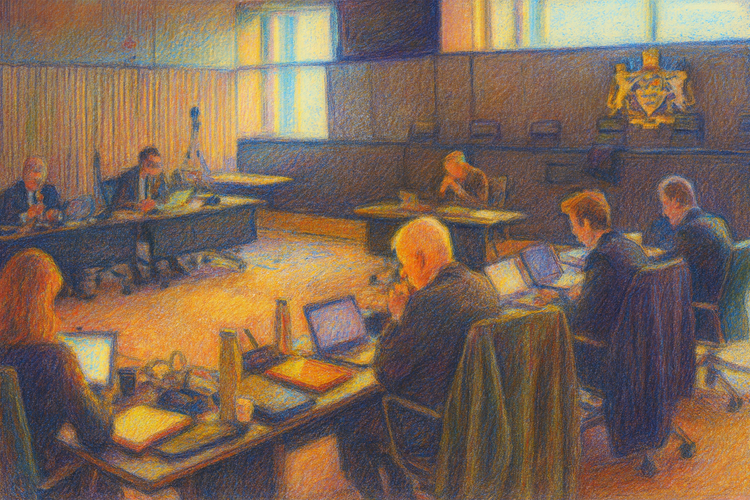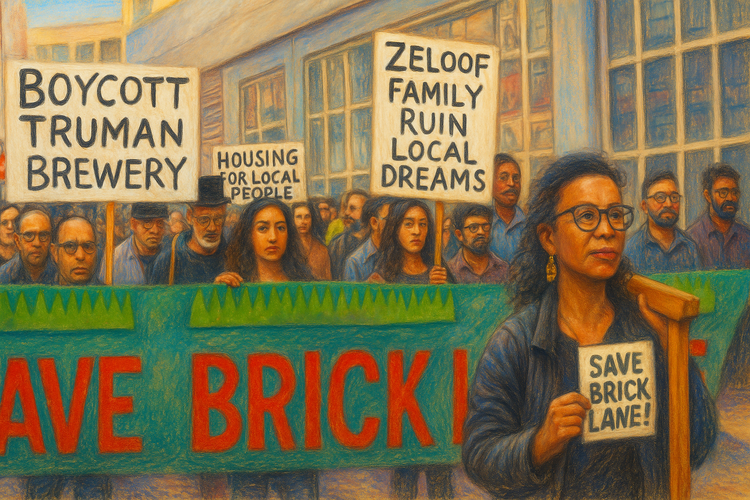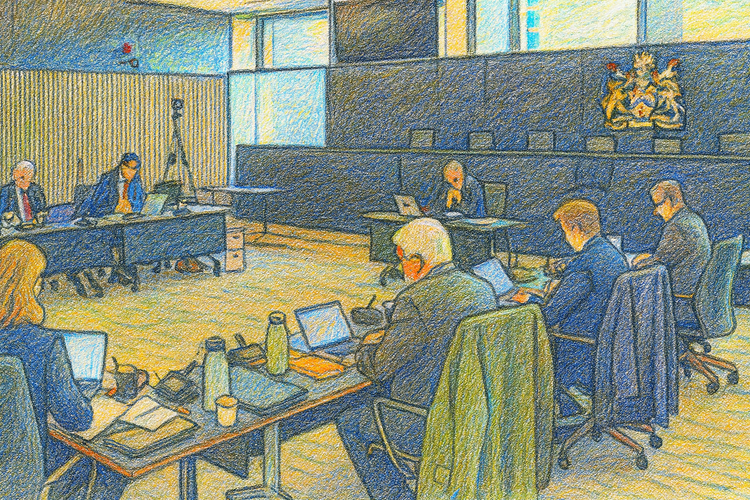Part III — London for Sale: An Open Objection to Towards a New London Plan (2025)

This concluding essay in the series brings the argument into the present, addressing the 2025 draft of the New London Plan and the politics that produced it.
A City Rewritten in the Language of Delivery
The Greater London Authority’s consultation Towards a New London Plan (May 2025) promises a “streamlined strategy for growth.” Behind this managerial vocabulary lies a profound redefinition of the city itself. What earlier Plans framed as Good Growth—a balance between economic expansion and civic welfare—has been recast as deliverability: the ability to move capital rapidly through land. The Mayor’s blueprint commits London to building 880,000 dwellings in ten years, an output unprecedented since the 1930s. Yet its central innovation is not quantitative but ideological. Every safeguard that once protected design quality, heritage and public interest is relaxed in the name of “flexibility.” Planning becomes the facilitation of investment rather than the stewardship of place.
The Manufactured Scarcity Myth
The Plan invokes a permanent housing crisis to legitimate these exceptional measures. The statistics tell a different story. London today contains more dwellings per head than at any point in its history. Tens of thousands stand empty; others circulate permanently through short-let platforms and offshore portfolios. Entire blocks of build-to-rent and student towers remain partly unoccupied because they were designed for spreadsheets, not households.
The crisis is not one of quantity but of allocation. As the sociologist Manuel Aalbers observes, financialised housing systems create artificial scarcity by withholding stock from use to preserve value. The city’s emergency is therefore not shortage but hoarding—of property, of land, and of political will. Were existing dwellings brought into social use, the deficit would collapse overnight.
Thirty Years of Policy Drift
Over the past three decades the planning regime has been transformed by the logics of financialisation.
- 1990s–2000s: Deregulation and asset sales, justified as “urban renaissance,” transferred public land to private ownership.
- 2010s: The invention of Opportunity Areas and viability testing normalised developer control over public outcomes.
- 2020s: The discourse of Good Growth, introduced as a moral corrective, is now being stripped of force.
The May 2025 consultation proposes to erase London-specific protections wherever national policy overlaps. The effect would be to dissolve the city’s ability to defend its skyline, its heritage and its local autonomy—reducing metropolitan planning to an appendage of central government and finance.
Heritage as Carbon Commodity
In Section 4.4 the consultation reframes heritage as a technical component of the net-zero agenda—valuable only insofar as it can be retrofitted for energy efficiency. The vocabulary of preservation gives way to that of performance. The city’s memory is re-described as an emissions variable.
The American geographer David Harvey once called this process the “annihilation of space by time”: the conversion of slow material endurance into abstract exchange units. When heritage is justified by carbon accounting, it becomes an environmental derivative. A Victorian warehouse is no longer protected because it embodies collective history but because its retrofit saves a tonne of carbon compared with demolition. Conservation, one of the earliest forms of sustainability, is subordinated to a financial ecology that values culture only when it yields a measurable return.
The Politics of Viability
The Plan’s procedural core is viability testing. Every social, ecological or architectural standard—affordable housing quotas, environmental thresholds, public-realm design—is conditional on profitability. What began as a safeguard against unbuildable schemes has become a charter for deregulation. Under this arithmetic, need is negotiable while profit is absolute. Developers may plead insolvency to dilute obligations, and public authorities, dependent on land-sale revenue, are forced to comply. The outcome is a reversal of accountability: citizens subsidise private profit through the loss of social infrastructure, rising rents and the erosion of public space.
From Brick Lane to Brixton: One Story, Many Postcodes
Across the metropolis the same pattern repeats.
- Brick Lane, where the Truman Brewery redevelopment would replace a living marketplace with offices and luxury flats.
- Peckham Station Street, where small traders face eviction under a “transit-oriented” regeneration.
- Brixton, where music heritage and council housing are hollowed out by speculative conversions.
Each struggle reveals the same contradiction: consultation without power. Communities are invited to comment but never to decide. The participatory promise of planning has been reduced to a ritual of notification.
The Numbers That Matter
| Measure | 1995 | 2024 | Trend |
|---|---|---|---|
| Homes owned by individual owner-occupiers | ~70 % | ~48 % | ↓ 22 pts |
| Homes held by corporate landlords, funds or offshore vehicles | < 2 % | > 15 % | × 7 increase |
| Social-rent dwellings as % of stock | 31 % | 16 % | Halved |
| Long-term vacant homes (ONS) | ≈ 20 000 | ≈ 33 000 | + 65 % |
These figures, drawn from the Office for National Statistics and housing research groups, expose a structural—not demographic—crisis. Housing exists in abundance; what is scarce is access. Towards a New London Plan deepens the contradiction by promising more supply without altering ownership. It pledges to build faster and higher while leaving untouched the mechanisms that convert homes into investment vehicles.
Wider Voices of Concern
The consultation has provoked an unusual consensus among scholars, professional bodies and community networks.
Academic and research institutions
- LSE London (Professor Ian Gordon) condemns the draft as “a technocratic exercise detached from governance,” noting that the Mayor has “acquiesced to central-government edicts” while ignoring speculation and land-value capture.
- Dr Anna Pagani, King’s College London, observes that “since 1996, housing supply has outpaced household formation.” The problem, she writes, is not quantity but distribution: “the challenge is how we provide and manage homes.”
- The Highbury Group on housing policy rejects the government’s algorithmic target as “unsound,” urging a new assessment grounded in social need.
Civic and professional networks
- The London Forum warns that top-down targets compel boroughs to maximise scale, density and height even as 300,000 consented homes remain unbuilt.
- The London Assembly Planning and Regeneration Committee cautions that a “brownfield-first” policy will be meaningless if Green Belt release continues.
- The Protect Our Places (POP) Coalition—linking Save Brick Lane, Save Brixton, Save Ridley Road and Latin Elephant—argues that Opportunity Areas reproduce racialised patterns of displacement. “We need a London Plan for Londoners, not developers,” their statement declares.
Together these voices describe a city whose governance has been hollowed out by finance. Even establishment organisations concede that viability spreadsheets and speculative valuation have replaced public interest as planning’s organising principle. “Streamlining” is understood for what it is: the bureaucratic form of deregulation.
Echoes in the Tradition of Urban Thought
“The city is a product of earth, of time, of love; it is not an act of will or a mere aggregation of money.”
— Lewis Mumford, The City in History (1961)
Mumford warned that when a metropolis becomes “a money-making machine divorced from the needs of life,” it begins its own decline. His prophecy describes London today with unsettling precision.
“Cities have the capability of providing something for everybody, only because, and only when, they are created by everybody.”
— Jane Jacobs, The Death and Life of Great American Cities (1961)
Jacobs’s vision of incremental, participatory urbanism—the city as a collaborative fabric of small actors—stands in stark contrast to the technocratic calculus of the 2025 Plan.
“Regeneration has become a euphemism for social cleansing.”
— Anna Minton, Ground Control (2009)
Minton’s account of Britain’s property boom as a system of financial extraction disguised as renewal has become orthodoxy. The new Plan perfects the inversion: substituting citizenship with yield, and community with compliance.
What Must Change
- Retain the Good Growth principles as binding obligations, not advisory notes.
- Define Conservation Areas as non-capacity zones exempt from borough housing quotas.
- Reinstate a dedicated Heritage and Culture chapter safeguarding both tangible and intangible heritage.
- Publish a public lobbying register for all Opportunity Area and strategic-site designations.
- Prioritise empty and under-used housing as capacity before sanctioning new speculative schemes.
- Embed socio-economic impact assessments alongside environmental and transport appraisals.
A Democratic London Plan
Planning, at its origin, was a moral as well as technical enterprise—the attempt to align private development with public good. The May 2025 draft treats it instead as a logistics problem: how to move units of capital efficiently through land. A democratic London Plan would invert that premise, restoring deliberation, accountability and redistribution to the centre of spatial policy. The closing date for consultation—22 June 2025—should mark not the end of discussion but its renewal.
Reclaiming the Future
London’s greatness was not built by speculation but by solidarity—by communities that repaired, reused and renewed their environment through time. A planning system that forgets this history will build neither homes nor hope. To recall the injunction of Lewis Mumford, the task is to restore the organic relation between place and purpose. The next London Plan must serve the living city, not the trading floor.
Index
Aalbers, Manuel B. — Economic sociologist; theorist of housing financialisation; explains how global capital transforms dwellings into investment vehicles and creates artificial scarcity.
Anna Pagani, Dr. — King’s College London researcher; argues that supply has exceeded household growth and calls for “repair, retrofit, and redistribution.”
Brick Lane — East London market district facing displacement through the Truman Brewery redevelopment; emblem of heritage loss and financialised regeneration.
Brixton — South London district where speculative conversions threaten music heritage and social housing.
Carbon Offsetting and Heritage — Policy framework valuing historic buildings for emissions savings rather than cultural meaning.
Conservation Areas — Local designations protecting historic fabric; threatened by new housing-capacity targets.
Deliverability — Planning term denoting speed and throughput of development; central organising logic of the 2025 Plan.
Financialisation of Planning — Subordination of public standards to profitability; “viability” as governing principle.
Good Growth — Earlier London Plan ethos linking economic and social objectives; diluted in the 2025 consultation.
Green Belt — Protected metropolitan land at risk of incremental release under “brownfield-first” rhetoric.
Highbury Group — Independent housing policy network; critiques algorithmic targets as “unsound.”
Ian Gordon, Professor — LSE London; describes the consultation as “technocratic” and detached from governance.
Jane Jacobs — Urban theorist; advocate of participatory, mixed-use neighbourhoods; contrasts sharply with the Plan’s technocratic logic.
Lewis Mumford — Historian of the city; warned that when cities become “money-making machines,” they decline.
London Assembly Planning and Regeneration Committee — Official body warning that “brownfield-first” will fail without Green Belt restraint.
London Forum — Civic federation; argues that high housing targets yield poor-quality, high-density units and family displacement.
Manufactured Scarcity — Condition in which housing supply is restricted to preserve asset values; hallmark of financialised markets.
Minton, Anna — Author of Ground Control; describes regeneration as “a euphemism for social cleansing.”
Opportunity Areas (GLA) — Spatial growth zones repackaging land and infrastructure for investment; linked to displacement.
Protect Our Places (POP) Coalition — Alliance of community campaigns (Save Brick Lane, Save Brixton, Save Ridley Road, Latin Elephant); demands recognition of local markets as social infrastructure.
Right-to-Buy — 1980s policy initiating the transfer of public housing into private ownership and speculation.
Social Housing Decline — Reduction from 31 % of stock (1995) to 16 % (2024); emblem of structural shift from welfare to investment.
Streamlining — Policy euphemism for deregulation and centralisation of planning powers.
Towards a New London Plan (2025) — Greater London Authority consultation embedding viability logic and speculative targets.
Viability Testing — Assessment of profitability used to waive social or environmental obligations; mechanism of policy capture.
Working Dossier on the London Plan (2025) — Forthcoming ConserveConnect research compendium expanding this critique.




